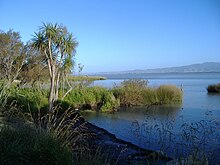
New Zealand has several notable wetlands but 90% of wetland areas have been lost following European settlement.
The Resource Management Act 1991, the major Act of Parliament determining land use, defines wetlands as "permanently or intermittently wet areas, shallow water, and land water margins that support a natural ecosystem of plants and animals that area adapted to wet conditions". The Ramsar Convention, an international conservation agreement for wetlands to which New Zealand signed up to in 1971, has a wider definition of wetland.
Since the mid-19th century, New Zealand has lost about 90% of its wetland areas due to draining for farming. Many remaining wetlands are also degraded due to pollution, grazing, drainage and presence of invasive plants. In the late 20th and early 21st century, efforts have been made towards wetland conservation.
Ramsar sites
The Department of Conservation currently administers seven Ramsar sites protected under the Ramsar Convention, covering an area of about 56,000 hectares (140,000 acres).
- Awarua Wetland
- Farewell Spit
- Firth of Thames
- Kopuatai Peat Dome
- Manawatu river mouth and estuary
- Wairarapa Moana Wetland
- Whangamarino Wetland
Other wetlands
Other notable wetlands in New Zealand include Ahukawakawa Swamp, Aramoana, the Kepler Mire, Kai Iwi Lakes, the Sinclair Wetlands, and Te Henga, as well as areas around the lower reaches of the Waikato River.
The Rakatu Wetlands in the South Island are part of an ecological restoration project set up address the environmental effects of the construction of the Manapouri Power Station.
Travis Wetland is a restoration project covering 116 hectares (290 acres) of land in urban Christchurch.
See also
References
- Johnson, Peter; Philippe Gereaux (2004). Wetland types of New Zealand (PDF). Department of Conservation (New Zealand). ISBN 0-478-22604-7.
- "Chapter 7: Key points". State of New Zealand's Environment 1997. Ministry for the Environment. Retrieved 28 May 2010.
Wetland areas have been reduced by about 85 percent in the last century and a half, from nearly 700,000 hectares to about 100,000 hectares.
- "Who administers the convention?: About DOC's international wetlands role". Department of Conservation. 2012. Archived from the original on 18 October 2012. Retrieved 18 December 2012.
- "Site list" (PDF). ramsar.org. Ramsar.
Further reading
- Cromarty, P.; Scott, D.A, eds. (1995). A Directory of Wetlands in New Zealand (PDF). Wellington: Department of Conservation. ISBN 0-478-01776-6.
- Johnson, Peter N (1998). Wetland plants in New Zealand. Canterbury, N.Z.: Manaaki Whenua Press. ISBN 9780478093216.
- Johnson, Peter; Gerbeaux, Philippe (2004). Wetland types in New Zealand (PDF). Wellington, N.Z.: Dept. of Conservation. ISBN 978-0-478-22604-1.
- Hunt, Janet (2007). Wetlands of New Zealand. Random House New Zealand. ISBN 978-1-86941-904-2.
- Tanner, C.C.; Sukias, J.P.S.; Yates, C.R. (2010), New Zealand Guidelines for Constructed Wetland Treatment of Tile Drainage (PDF), NIWA Information Series No. 75, NIWA, ISSN 1174-264X
- Peters, Monica; B. R Clarkson (2010). Wetland restoration : a handbook for New Zealand freshwater systems. Lincoln, N.Z: Manaaki Whenua Press. ISBN 978-0-478-34706-7.
- "Arawai Kakariki wetland restoration programme 2007-2010: Implementation report". Department of Conservation. December 2011.
External links
- Department of Conservation – wetlands conservation page
- The National Wetland Trust of New Zealand
- Wetlands in Te Ara – the Encyclopedia of New Zealand
This New Zealand-related geography article is a stub. You can help Misplaced Pages by expanding it. |